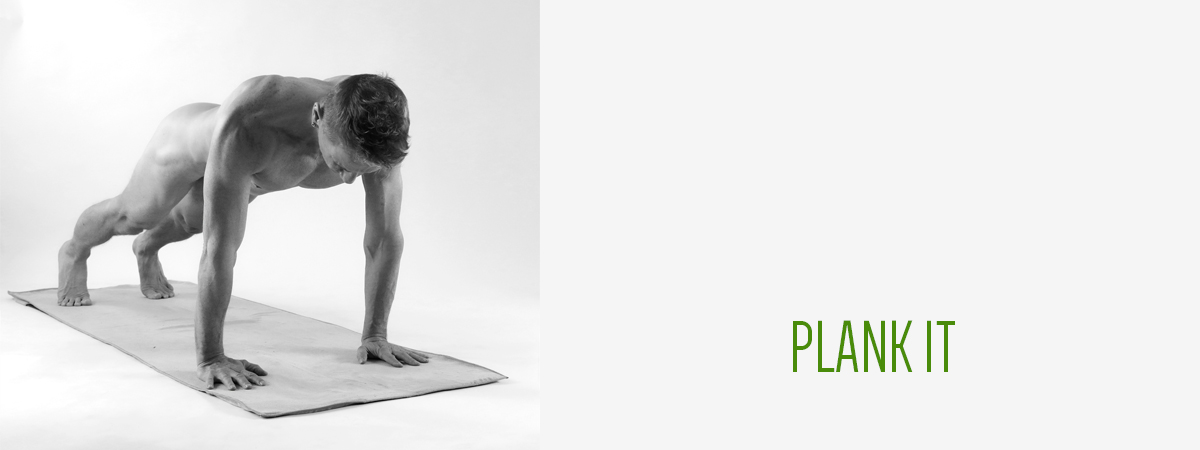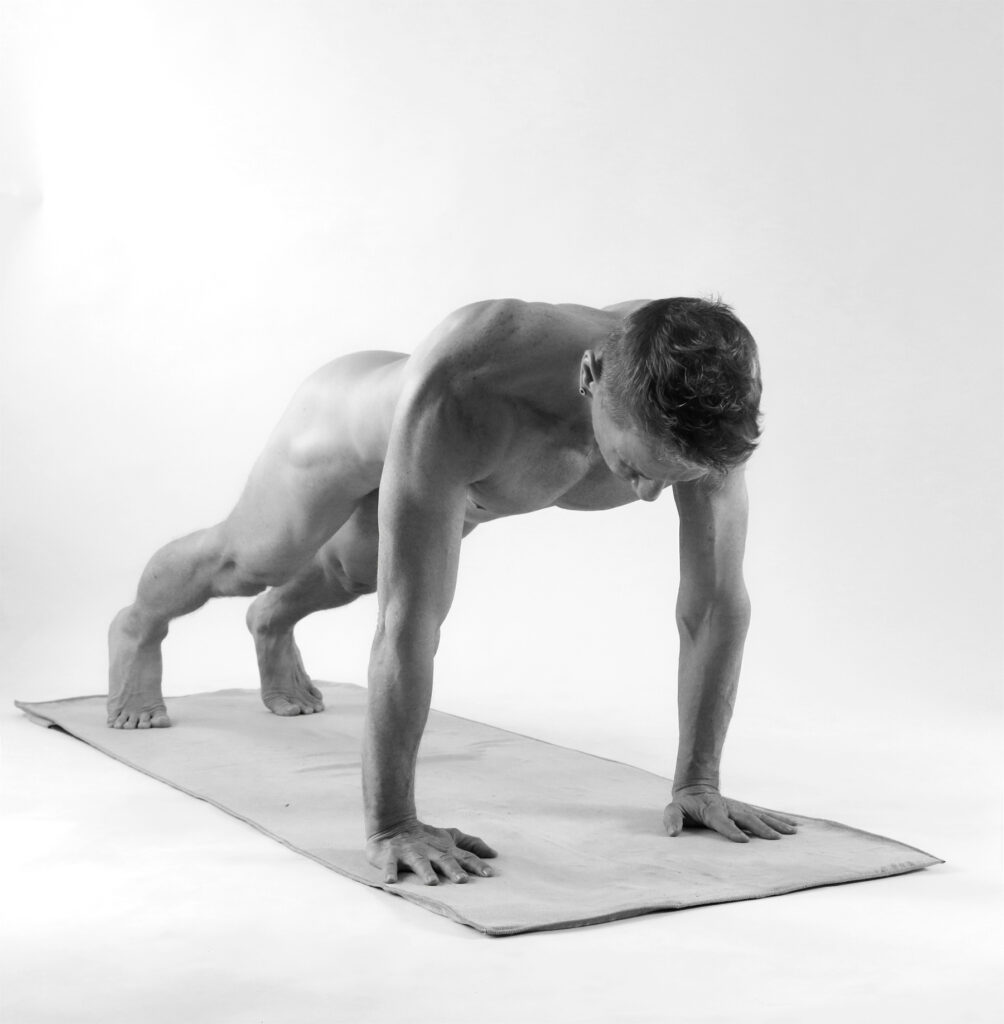
Love ‘em or hate ‘em, planks should be part of everyone’s workout routine.
Although planks look easy, they are anything but and can seriously boost your fitness levels. Planks are one of the most effective exercises you can do that will never go out of fashion. The beauty of this powerful bodyweight exercise is that planks don’t require any equipment and can be done virtually anywhere, engage multiple muscle groups simultaneously and benefit your whole body in a variety of ways.
The horizontal ab-crusher comes in endless variations… Perform it on your palms, your forearms, on your side or use an unstable surface like a stability ball. Plank is simply one of the best exercises for core conditioning that improves your posture, keeps your back healthy, enhances overall movement and coordination and of course, tones your midsection. As basic as they may seem, there is actually a lot that goes into the perfect core-shaking plank, so let’s look at how it’s done.
How to Do Plank
* Start on your hands and knees, with your hands shoulder-width apart and your knees hip-width apart.
* Extend your legs back so you bring your body to full extension.
* Push your heals towards the back and reach the crown of the head forward simultaneously, engage your legs so they are completely straight, keep your core tight, pulling the belly button towards the spine while keeping your pelvis slightly tucked and make sure your shoulders are directly over your wrists.
* Think length and create one line of energy from your heals to the crown of the head and make sure your hips are neither sagging like a suspension bridge nor too high like a downward facing dog.
* Keep your neck and spine in a neutral position and try aiming your chin about six inches ahead of you.
* Push your palms firmly against the ground, make sure your shoulder blades are floating on the back. Don’t forget to keep your entire body engaged.
* Aim to hold plank for about 30 seconds and work your way up to 60 to 90 seconds once you get stronger. In the beginning, you may want to lower your knees for support.
* Remember to keep breathing!
Is your core on fire, yet? Great, let’s move into some PLANK VARIATIONS
Forearm Plank
This variation is slightly easier than holding your body up with just your hands, it’s also a great choice if you have wrist issues. Place your forearms on the ground with your elbows right below your shoulders and your forearms parallel to each other. You can either have your palms flat on the ground or clasp your hands together.
Note: Any of the following variations can be done either on your palms or your forearms
Knee Plank
If you don’t have the strength, yet, rather than compromising your form, make it easier by resting your knees on the ground. This will also lessen stress on the lower back and it’s a great way to allow concentrating on your form. Sometimes it’s a good idea to place a towel underneath your knees for some cushioning.
Side Plank
If you want to target your obliques, side plank is the way to go. Start in plank and shift your weight to one arm while stacking your legs on top of each other with your feet flexed. You want to make sure that your shoulder is directly over your wrist. Remember, you have almost all of your weight in one hand, you want to make sure to avoid injuries. You can modify by raising your top leg into the air to make side plank more difficult or cross the upper leg in front of the body for additional support to make it easier.
Single-Leg Plank
To increase the demand on your core, remove one point of contact from the ground. Start in a basic plank pose and then lift one leg toward the ceiling. Make sure your hips stay parallel to the ground and don’t compromise your back. Alternate legs.
Reverse Plank
Start out by sitting on the floor with your legs straight out in front of you. Place your palms shoulder-width apart on the floor about six inches behind your butt, fingers facing towards you. Lift your hips off the ground, keeping your body in a straight diagonal line from the crown of the head to your toes.
Stability Ball Plank
To really have some fun and up the ante, plant your hands on a stability ball, rather than the floor. Stabilizing the body on an unstable ball adds a balancing component to plank which increases the demand on your core.
Now that we have a variety of planks we can choose from, let’s look at what happens when you plank every day.

#1 Improve Core Strength
If you are working towards your six pack, planks are the perfect exercise because they engage all major core muscles at the same time. Crunches usually target just one area of your core, but it is important to strengthen each core muscle group, as they all serve their own purpose. If you strengthen your transverse abdominis, you’ll be able to lift heavier weights. A stronger rectus abdominis improves sports performance and is responsible for giving you the highly coveted six pack look. Strengthening your obliques will improve your ability to twist and side-bend with more ease.
#2 Decrease Risk of Back Injury
Doing planks on a regular basis strengthens your back muscles and ensures a strong support for your entire back, significantly reducing the risk of back injuries and back pain. Planks are the type of exercise that allow you to build muscle without putting too much pressure on your spine.
#3 Boost Metabolism
Planks challenge your entire body and burn more calories than traditional ab exercises like sit-ups and crunches. If you practice plank every day, you strengthen your muscles, which will ensure that you burn more energy even after your workout. If you feel a midday slump because you are sitting in front of a computer all day, do a plank in the office to ensure your metabolic rate will remain high all day long.
#4 Improve Posture
The muscles in your abdomen have a huge effect on the overall condition of your neck and shoulders, chest and back. Strengthening your core while doing planks, you will greatly improve your ability to stand with a stable posture and maintain proper posture at all times.
#5 Improve Balance
Have you ever tried standing on one leg, only to realize that you couldn’t balance for more than a few seconds? It’s probably because your abs weren’t strong enough to give you the balance you need. You will greatly improve your balance by doing planks and side planks in all kinds of variations and boost your performance in any kind of sport.
#6 Improve Bone & Joint Health
Physical activity doesn’t just tone your muscles and keep your heart healthy, it is vital for bone strength and supple joints. Weight-bearing exercises in particular are key for bone health because they put stress on the bones, stimulating them to rebuild themselves. Supporting your own body weight in plank is a great weight-bearing exercise that will help keep your bones strong.
#7 Increase Flexibility
Staying flexible is vital in order to prevent injury. Plank can offset some of the natural loss of elasticity of the muscles, tendons and ligaments that come with age, especially for those who sit at a desk all day. Planks maintain and increase flexibility by stretching and expanding the muscles around the shoulders, shoulder blades, collarbone, hamstrings and even the arches of your feet. Add some side planks into the mix and you stretch your obliques as well, especially when you extend your arm over your head in line with the rest of your body.
#8 Be Happier and Less Stressed
Like any other exercise, planks can lift your spirits and raise your energy levels. Particularly if you sit in front of a computer all day, plank stretches and relaxes the muscles in the neck and shoulders, which can lift your mood. Additionally, plank is recommended as a stress reduction exercise, as planks are said to help calm the mind.
Planks may not look like much, but sometimes the simplest of movements result in the greatest gains to your fitness.
ARE YOU PLANKING?
Joschi & Monika
#BoldNaked

Pingback: PLANK IT | Nudie News